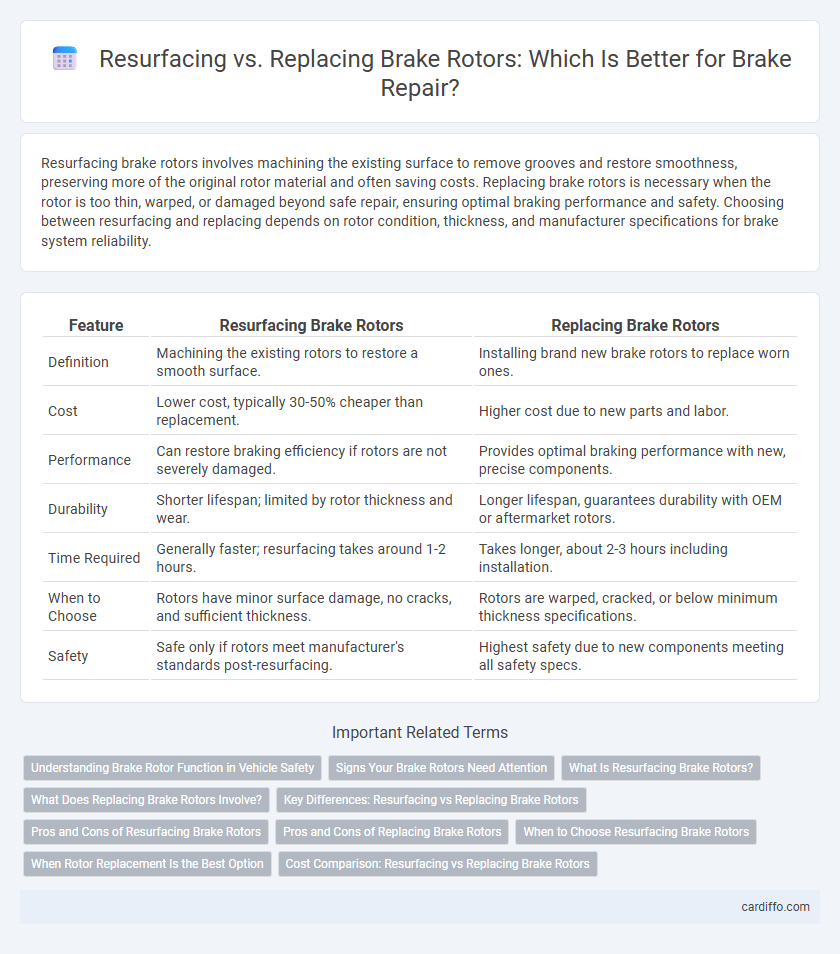Resurfacing brake rotors involves machining the existing surface to remove grooves and restore smoothness, preserving more of the original rotor material and often saving costs. Replacing brake rotors is necessary when the rotor is too thin, warped, or damaged beyond safe repair, ensuring optimal braking performance and safety. Choosing between resurfacing and replacing depends on rotor condition, thickness, and manufacturer specifications for brake system reliability.
Table of Comparison
| Feature | Resurfacing Brake Rotors | Replacing Brake Rotors |
|---|---|---|
| Definition | Machining the existing rotors to restore a smooth surface. | Installing brand new brake rotors to replace worn ones. |
| Cost | Lower cost, typically 30-50% cheaper than replacement. | Higher cost due to new parts and labor. |
| Performance | Can restore braking efficiency if rotors are not severely damaged. | Provides optimal braking performance with new, precise components. |
| Durability | Shorter lifespan; limited by rotor thickness and wear. | Longer lifespan, guarantees durability with OEM or aftermarket rotors. |
| Time Required | Generally faster; resurfacing takes around 1-2 hours. | Takes longer, about 2-3 hours including installation. |
| When to Choose | Rotors have minor surface damage, no cracks, and sufficient thickness. | Rotors are warped, cracked, or below minimum thickness specifications. |
| Safety | Safe only if rotors meet manufacturer's standards post-resurfacing. | Highest safety due to new components meeting all safety specs. |
Understanding Brake Rotor Function in Vehicle Safety
Brake rotors play a crucial role in vehicle safety by providing a surface for brake pads to clamp down on, enabling effective slowing or stopping. Resurfacing brake rotors can restore a smooth braking surface, extending rotor life and maintaining proper brake function when wear is minimal and rotor thickness meets safety standards. Replacing brake rotors is essential when rotors are too thin, warped, or damaged, ensuring optimal braking performance and preventing brake failure.
Signs Your Brake Rotors Need Attention
Warped or grooved brake rotors cause vibrations and noise during braking, signaling the need for resurfacing or replacement. Visible cracks, deep scoring, or rust buildup indicate rotor damage that can compromise braking performance and safety. Measuring rotor thickness below manufacturer specifications is a critical sign that replacement is necessary to maintain optimal brake function.
What Is Resurfacing Brake Rotors?
Resurfacing brake rotors involves machining the surface to remove grooves, rust, and imperfections, restoring a smooth and even finish for better brake pad contact. This process extends rotor life and improves braking performance without the cost of full replacement. Resurfacing is recommended when rotors have minor wear, warping, or surface damage but still maintain sufficient thickness for safe operation.
What Does Replacing Brake Rotors Involve?
Replacing brake rotors involves removing the wheel, caliper, and old rotor before installing a new rotor aligned with the hub. The process requires inspecting the brake pads and hardware for wear to ensure optimal braking performance. Properly torquing the lug nuts after reassembly is essential for safety and longevity of the brake system.
Key Differences: Resurfacing vs Replacing Brake Rotors
Resurfacing brake rotors involves machining the surface to restore smoothness and extend rotor life, suitable when rotors have minor wear or light grooves. Replacing brake rotors is necessary when rotors are too thin, warped, or cracked, ensuring safety and optimal braking performance. Key differences include cost, rotor thickness limits, and the severity of rotor damage affecting the choice between resurfacing and replacement.
Pros and Cons of Resurfacing Brake Rotors
Resurfacing brake rotors restores a smooth surface by removing minimal material, extending rotor life and reducing replacement costs; however, it may not be effective if the rotors are severely warped or below the minimum thickness specification. This process improves braking performance and reduces vibrations but can compromise rotor structural integrity if performed excessively. Choosing resurfacing over replacement depends on rotor condition, cost considerations, and vehicle safety requirements.
Pros and Cons of Replacing Brake Rotors
Replacing brake rotors ensures improved braking performance by eliminating deep grooves, warping, or thinning that resurface methods might not fully address. New rotors provide enhanced reliability and safety, reducing vibrations and brake fade during intense driving conditions. However, replacement costs are higher than resurfacing, and it involves more labor-intensive work, potentially increasing overall maintenance expenses.
When to Choose Resurfacing Brake Rotors
Choose resurfacing brake rotors when the rotors exhibit minor surface wear, such as light scoring or glazing, and maintain sufficient thickness above the manufacturer's minimum specification. This option preserves the original rotors by smoothing out imperfections and restoring a flat braking surface, reducing cost compared to full replacement. Resurfacing is ideal for maintaining brake system performance without compromising safety, especially when the rotor structural integrity remains intact.
When Rotor Replacement Is the Best Option
Rotor replacement is the best option when brake rotors are deeply scored, warped beyond machining limits, or have reached the minimum thickness specified by the manufacturer. Resurfacing is ineffective if the rotor's structural integrity is compromised or if excessive material removal would reduce its lifespan and safety. Modern vehicles often recommend replacement over resurfacing due to improved rotor materials and tighter performance tolerances.
Cost Comparison: Resurfacing vs Replacing Brake Rotors
Resurfacing brake rotors typically costs between $10 to $30 per rotor, significantly lower than replacement, which averages $50 to $150 per rotor depending on vehicle make and rotor quality. While resurfacing can extend rotor life and save money short-term, replacing rotors ensures optimal braking performance and reduces the risk of structural imperfections causing vibration or brake fade. Choosing between resurfacing and replacing depends on rotor thickness, damage severity, and long-term safety considerations.
Resurfacing vs replacing brake rotors Infographic

 cardiffo.com
cardiffo.com